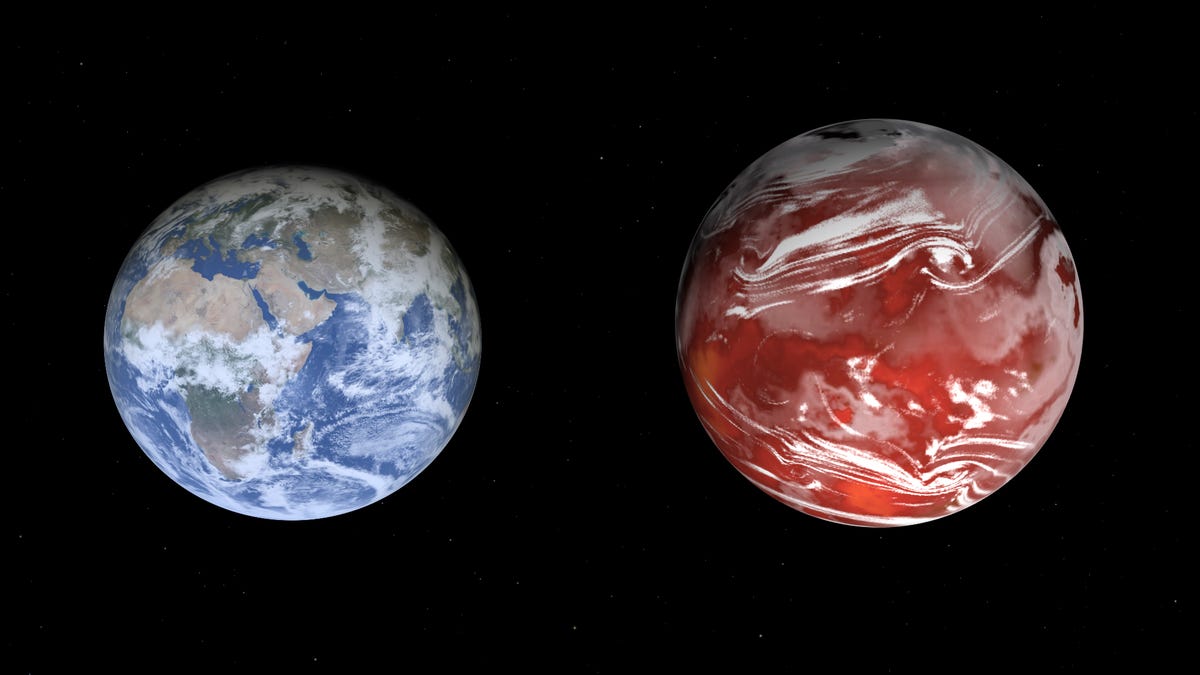NASA Telescopes Identify 2 Alien Worlds Composed Mostly of Water
With these devices, scientists might have found another exoplanet in its star's habitable zone, too.

On the left is Earth and on the right is NASA's hypothetical visualization of Kepler-138 d. However, note that this visualization was done based on the assumption that Kepler-138 d is a rocky world. The size ratio is likely accurate, though.
The '90s was an era of inspiration. It's when the first Sony PlayStation arrived, when Tickle Me Elmo began giggling across the US and when Google started its epic empire. But more precisely, in 1992, something absolutely magical happened.
Scientists found a planet beyond our solar system for the very first time, unlocking an entirely new avenue of space exploration: the hunt for alien worlds.
Since that galvanizing discovery, experts have managed to catalog thousands of exoplanets that starkly remind us of how relatively mild the eight orbs in our cosmic corner are.
These are places with gemstone rain showers, hellish lava lakes and exotic, unmeltable ice cliffs. There are even a handful of alternate reality Earth doppelgangers with the tantalizing potential to hold extraterrestrial life.
And on Thursday in the journal Nature Astronomy, a crew of exoplanet hunters announced that, once again, we've furthered our alien world repertoire.
Using NASA's orbiting Hubble and retired Spitzer Space Telescopes, scientists identified two exoplanets that seem to be immersed in blankets of none other than life's elixir: water.
Sitting in a star system about 218 light-years away, these azure globes named Kepler-138 c and Kepler-138 d orbit a dim, red dwarf star. They are about one and a half times the size of Earth and boast masses approximately twice as hefty as our planet's. You'd think they're kind of Earthy cousins, but oddly enough, these measurements make the Kepler duo's story a bit paradoxical.
"We previously thought that planets that were a bit larger than Earth were big balls of metal and rock, like scaled-up versions of Earth, and that's why we called them super-Earths," Björn Benneke, a professor at the University of Montreal and co-author of the paper, said in a statement. In fact, NASA's online Exoplanet Catalog still refers to Kepler d, for instance, as a "potentially rocky" world.
"However," Benneke continued, "we have now shown that these two planets, Kepler-138 c and d, are quite different in nature: a big fraction of their entire volume is likely composed of water."
All in all, this marks the first time anyone has confidently identified exoplanets as water worlds, which Benneke says is a type of planet theorized by astronomers to exist for a long time but yet to be proven with great certainty.
A cross-section of the Earth, on the left, is seen with an updated version of Kepler-138 d, in comparison to NASA's Exoplanet Catalog visualization, on the right. Water layers in Kepler-138 d are thought to dive as deep as about 2,000 km. The Earth, in comparison, has a negligible fraction of liquid water with an average ocean depth of less than 4 km.
Visualizing a world of vapor
Before we go any further, a major point worth mentioning is these so-called water worlds are not expected to have oceans like you'd imagine.
"The temperature in Kepler-138 c's and Kepler-138 d's atmospheres is likely above the boiling point of water, and we expect a thick, dense atmosphere made of steam on these planets," Caroline Piaulet, team lead and Ph.D. student at the University of Montreal, said in a statement. "Only under that steam atmosphere there could potentially be liquid water at high pressure, or even water in another phase that occurs at high pressures, called a supercritical fluid."
Yup, I had to erase my mental picture of a huge ocean blob suspended in outer space, sort of like the frightening water world Cooper visits in Interstellar only to be terrorized by towering skyscraper waves.
Rather, the researchers suggest the Kepler twins are more like larger versions of Europa or Enceladus, aka water-rich moons currently orbiting Jupiter and Saturn, except much closer to their star.
"Instead of an icy surface," Piaulet said, "Kepler-138 c and d would harbor large water vapor envelopes."
Technically, both of the studied exoplanets had been found by NASA's Kepler Space Telescope in the past (hence their names) but it wasn't until now that scientists felt they had confirmation of the spheres' composition. Though they'd already confirmed Kepler-138 b, which is also in the Kepler 138 red dwarf system, is a terrestrial planet about 0.0066 the mass of Earth, they needed further observations for c and d.
Hubble and Spitzer offered just that.
In March, NASA confirmed the existence of over 5,000 exoplanets.
Despite water not being directly detected, the team was able to use these NASA telescopes to compare the sizes and masses of the planets to models which suggested a significant fraction of these worlds' volume -- up to half of it -- should be made of materials lighter than rock, but heavier than hydrogen or helium, which are gasses.
And what sits right in the middle of rock and gas? Well, water.
"As our instruments and techniques become sensitive enough to find and study planets that are farther from their stars, we might start finding a lot more water worlds like Kepler-138 c and d," Benneke said.
Plus, an added bonus to the crew's observations was a new possible Kepler 138 planet baby: Kepler-138 e.
Piaulet and her team, according to a press release on the find, were surprised to see the presence of a fourth planet in the system that's smaller and farther from its star than the three others.
But perhaps most intriguingly, Kepler-138 e appears to sit in the habitable zone. Time will tell what, exactly, that might mean for true nature.

